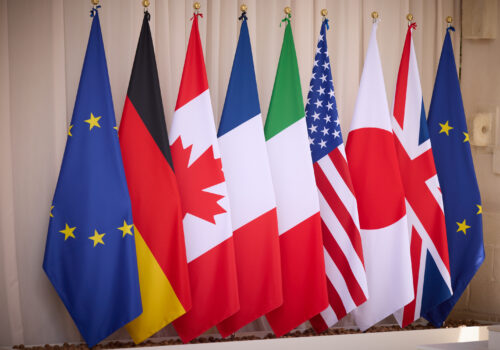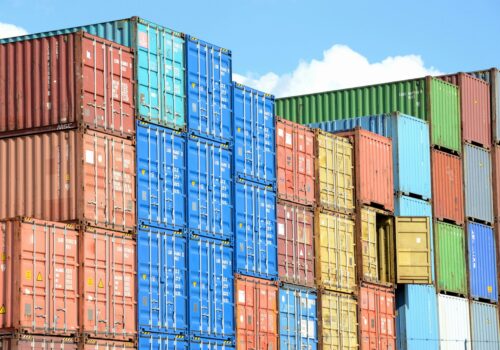The 2025 Group of Seven (G7) Leaders’ Summit in Kananaskis, Alberta, Canada, on June 15-17 will take place amid a growing recognition of the importance of digital resilience. This is especially apparent in Canada, the summit’s host country and current G7 president. Following his election win, Canadian Prime Minister Mark Carney announced the creation of a new Ministry of Artificial Intelligence and Digital Innovation. This bold step positions Canada to champion a digital resilience agenda at the summit that unites security, economic growth, and technological competitiveness while strengthening the resilience of its partners and allies.
The G7 must seize this opportunity to advance a coherent, shared framework for digital policy, one that is grounded in trust, reinforced by standards, and aligned with democratic values. To do so, it can build on some of the insights from the Business Seven (B7), the official business engagement group of the G7. The theme of this year’s B7 Summit, which was held from May 14 to May 16, in Ottawa, Canada, was “Bolstering Economic Security and Resiliency.” The selection of this theme emphasized the importance of defending against threats and enhancing the ability of societies, governments, and businesses to adapt and recover.
In the spirit of that theme, the Atlantic Council’s GeoTech Center, in partnership with the Cyber Statecraft Initiative and the Europe Center, convened a private breakfast discussion alongside the B7 in Ottawa on May 15. The roundtable brought together government officials, business leaders, and civil society representatives to discuss how digital resilience can be strengthened within the G7 framework. The participants laid out foundational principles and practical approaches to building digital resilience that support economic security and long-term competitiveness. As G7 leaders gather for the summit in Kananaskis later this month, they should consider these insights on how its member states can work together to bolster their digital resilience.
1. Develop a common language for shared goals on digital sovereignty
When developing a common framework, definitions (or taxonomy) are critical. Participants emphasized that shared vocabulary is a prerequisite for meaningful cooperation. Discrepancies in how countries define concepts such as digital sovereignty can lead to fundamental misunderstandings in critical areas such as risk, which creates friction and confusion.
For example, a G7 country might frame sovereignty in terms of national control over infrastructure while another country, such as China, defines it as regulating the digital information environment. In that case, this misalignment will hinder cooperation from the outset. Specifying precise definitions of each government’s goals, including “trust,” “resilience,” and “digital sovereignty,” would enable governments and industry to align on priorities and respond more effectively to emerging standards. This definitional clarity is crucial for policymaking and a prerequisite for compliance, implementation, and interoperability across borders.
2. Build on existing multilateral and regional frameworks
Participants stressed the importance of building on existing progress toward digital resilience, both in and out of the G7, rather than discarding it in pursuit of novelty. The G7 and its partners already possess a strong foundation of digital policy initiatives. Key milestones such as the Hiroshima AI Process, launched under Japan’s 2023 G7 presidency, established International Guiding Principles and an International Code of Conduct for the development and use of artificial intelligence (AI) systems, which included frontier models. Prior to the Hiroshima AI Process, several consecutive G7 Summits committed to developing the data free flow with trust framework, which prioritizes enabling the free flow of data across borders while protecting privacy, national security, and intellectual property.
Beyond the G7, participants cited European Union (EU) partnerships as examples of forward-leaning policy environments that balance innovation with safeguards. These included the EU AI continent action plan, which aims to leverage the talent and research of European industries to strengthen digital competitiveness and bolster economic growth, as well as Horizon Europe, the EU’s primary financial program for research and innovation.
With these partnership frameworks already in place, G7 leaders should build on existing work and avoid seeking to design unique solutions that may become time-consuming—particularly when it comes to gaining political buy-in. Even in areas like AI and the use of data, where policymakers have observed rapid changes since last year’s summit, the B7 discussion participants emphasized that governments can leverage work they’ve already completed in designing and implementing existing standards. If prior technical standards and regulations are inapplicable or insufficient, policymakers can still learn lessons from an in-depth assessment, including by taking note of where they’ve fallen short of their goals.
3. Start new initiatives with small working groups and pilot projects
Ensuring digital resilience requires managing inevitable trade-offs between national security, economic vitality, and open digital ecosystems. As one participant remarked, “the digital economy is the economy,” so policies shaping cyberspace must consider both national security and economic impacts. The G7 provides a platform for frank discussions among allies and partners about how to get these trade-offs right. But waiting for buy-in from all like-minded partners risks missed opportunities in the short term.
Participants noted that by starting with smaller forums, policymakers can build consensus that can lead to real progress. Pilot projects and working groups among smaller clusters of G7 countries could build momentum and inform scalable solutions. Participants emphasized that despite the contentious nature of some of the issues surrounding digital resilience, such as protectionism and market fragmentation, G7 governments are operating with a shared set of values. These values can motivate collaboration across the G7 on the many areas of common ground they already share, but they can also provide the basis for projects among smaller groups within the G7 to get new ideas off the ground.
A pivotal summit for digital resilience
As G7 leaders meet in Kananaskis and work toward a common framework that balances digital security and economic growth, a few key lessons can be garnered from this B7 meeting. G7 member states should prioritize developing a common taxonomy and building on the progress made on digital resilience both inside and outside the G7, all while remaining responsive to shifting geopolitical dynamics.
Disagreements among member states should be viewed not as a barrier, but as evidence of a maturing policy landscape. Constructive tension can drive refinement so long as partners are clear about their priorities. The G7’s unique value lies in its ability to forge alignment among diverse actors. False consensus only delays progress. It will take transparency, specificity, and trust to move the digital resilience agenda forward.
Sara Ann Brackett is an assistant director at the Atlantic Council’s Cyber Statecraft Initiative.
Coley Felt is an assistant director at the Atlantic Council’s GeoTech Center.
Raul Brens Jr. is the acting senior director of the Atlantic Council’s GeoTech Center.
Further Reading

The GeoTech Center champions positive paths forward that societies can pursue to ensure new technologies and data empower people, prosperity, and peace.
Image: May 16, 2025, Ottawa, On, CAN: U.S. Ambassador to Canada Pete Hoekstra speaks at the Canadian Chamber of Commerce B7 Summit, in Ottawa, on Friday, May 16, 2025. Credit Image: © Justin Tang/The Canadian Press via ZUMA Press.




